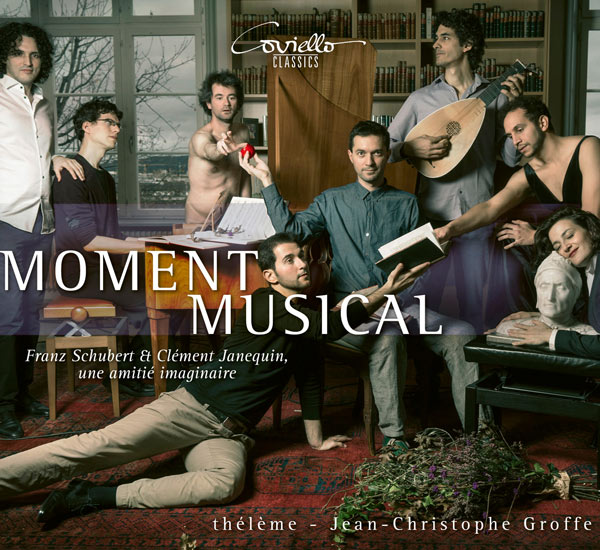
Moment Musical
thélème
Edition: Coviello Classics
Booklet: de / en / fr
Media: CD / HD Download
COV 91724
The ensemble thélème shows us surprising parallels between two composers of quite different provenance: The Viennese early-romantic Franz Schubert and the French Renaissance master Clément Janequin. Both composers are known for their songs and chansons. There are also similarities between the careful treatment of the text, the well-thought-out selection of the authors and the refined setting of the texts with detailed accompaniment. Love and contemplatism were often used as topics. Also, both masters seemed to have a chronic shortage of money.
thélème
Solenn’ Lavanant-Linke · mezzo-soprano
Rani Orenstein · piano-forte
Julien Freymuth ⋅ alto
Lior Leibovici & Ivo Haun ⋅ tenor
Breno Quinderé ⋅ baritone
Ziv Braha ⋅ lute
Jean-Christophe Groffe ⋅ bass and direction
| Franz Schubert (1797-1828) | ||
| 1. | Leise, leise, lasst uns singen (D 635) | 1:10 |
| 2. | Der Gondelfahrer (D 809) | 2:52 |
| 3. | Moment Musical, Moderato (op. 94, 1-D 780) | 5:45 |
| 4. | An die Nachtigall (op. posth. 172, 3-D 196) | 1:30 |
| 5. | Selig durch die Liebe (D 55) | 1:43 |
| 6. | Moment Musical, Andantino (op. 94, 2-D 780) | 6:27 |
| 7. | Im Gegenwärtigen Vergangenes (D 710) | 6:27 |
| Clément Janequin (c.1485-1558) | ||
| 8. | Toutes les nuictz (1547) | 2:07 |
| 9. | L’alouette (1528) | 2:39 |
| Adrien Le Roy (1520-1598) | ||
| 10. | Fantaisie (1551) | 3:07 |
| Clément Janequin | ||
| 11. | Le chant des oyseaux (1537) | 6:04 |
| 12. | L’amour, la mort, la vie (1540) | 1:57 |
| Adrien Le Roy | ||
| 13. | Suite de Branles de Bourgogne (1551) | 4:11 |
| Claudin de Sermisy (1490-1562) | ||
| 14. | Languir me fais (1528) | 2:52 |
| Clément Janequin | ||
| 15. | Le rossignol (1537) | 2:07 |
| Franz Schubert | ||
| 16. | Die Nachtigall (op. 11, 2-D 724) | 4:04 |
| 17. | Moment Musical, Allegro Moderato (op. 94, 3-D 780) | 1:45 |
| 18. | Ständchen (op. posth. 135, D 920) | 4:45 |
| 19. | Zur Guten Nacht (op. 81, 3-D 903) | 4:41 |
| Total time: | 1:05:48 | |
